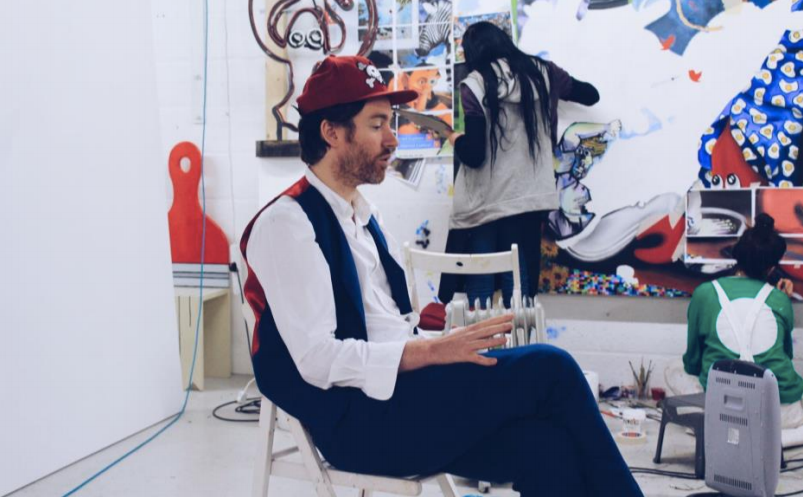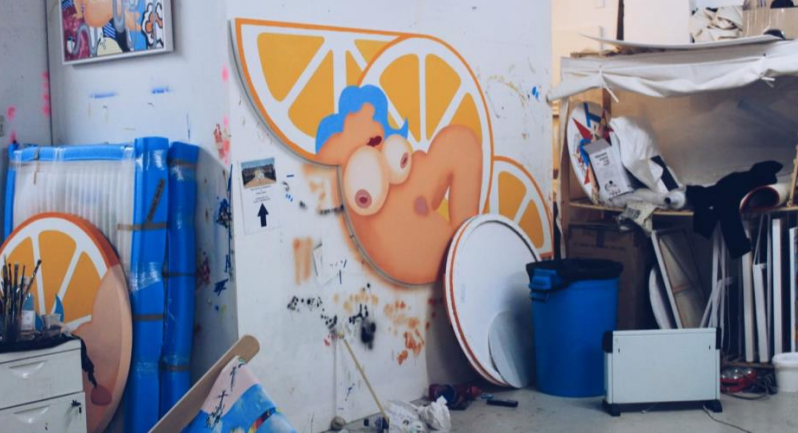Interview and Studio Visit with 'the Godson of Andy Warhol'
Written by Eleanor Stephenson.
Photographs by Juliet McLoughlin

E.S. André Leon Talley, the former editor of Vogue, called you ‘the Godson of Andy Warhol’, how did that come about?
P.C. I was doing a performance in New York for the Rodnik Band and he came along to the show. He said, “Oh my god this is amazing, this is like the Velvet Underground, it’s so crazy. Andy Warhol would have loved this. You remind me of Andy Warhol.” It was just a comment he made in a small article and it stuck!
You are clearly concerned with contemporary popular culture however, you also include references to famous paintings, is art history important in your practice?
Very much. It’s the language. I think that painting is like a language, like poetry or anything else. There is a past and a dialogue, which people enter into with a pre-conceived idea about what that language is. What determines a good painting or a bad painting? That’s what art history is, a shelved collection of references to the past, however, obviously there were lots of great paintings that didn’t make it into art history. This rich record of history creates a language, which is sometimes more interesting to work with than just the contemporary dialogue. I am particularly interested in the grand battle scenes from the seventeenth century.

What’s your process?
It’s actually only recently that I have been working with historic figures, rather than just popular culture. Rubens was the artist I was drawn to the most; I almost had the imagery in my head. The reason I stuck with the Rubens battle scenes is for their celebration of battle, of violence, which is so prevalent in our society today. Liberalism creates the clean sheen on things, as if we are superior and have not evolved from the past. We know the mechanics behind our culture are actually deeply dark and violent. Liberals may get frightened by a lion attack, but actually, it’s not violent at all in comparison to contemporary culture. I wanted to get an image of violence and amplify it, with reference to contemporary culture.
In the same way that Pop Art was a critique and a celebration of society, your work has elements of parody.
Humour is key to me, humour is the closest thing you can get to the truth in my opinion. Humour is the shacking of the cage rather than the building of the structure. The good thing with humour: it parodies all of our absurd systems. Humour is a positive tool, which is reflected in primary and bright colours. I like primary colours because they have a primary, positive impact. I like mixing these primary colours with a sort of satire.
How do you feel about the term ‘Pop Art’?
And who inspired you the most from 1960s America? I believe in the philosophy of Pop. The everyday commonplace object is what unites people across the world. I see a holiness in the everyday because our lives are the ultimate essence of everything. The everyday, whether in the kitchen, or eating, have a very subconscious power to them. With the Pop Art movement, artists were working with the difference between high and low art. I want to explore the realities of everyday modern culture. Lichtenstein was interesting because he engaged with art history, he started to recontextualise Picasso, thus recycling history within a narrative. Wesselman followed on from artists such as Matisse; he had a very idealised version of Pop which I think is outdated today.
“People don’t understand that Pop was not a movement but is a philosophy. If you are a Pop artist, you engage with that philosophy, in a way that feels relevant today.”

Andy Warhol once said, “Being good in business is the most fascinating kind of art. Making money is art and working is art and good business is the best art.” You once said that the Rodnik Band is the way you make money but your passion is art. How do you feel about art and business?
Art and business is a complex thing, I think it can work really well if you have a good formula and a good product, but sometimes bad art makes a lot of money. If art is about communicating, sometimes there is a snobbery about art, for it to be valuable it needs to have a snobbish secrecy and exclusivity. Keith Herring was a great artist but also a great businessman. With The Rodnik Band, I wanted to create a hybrid cross-over of art, fashion and business. I came back to painting to have more freedom with image-making, rather than be limited by the restrictions of a commercial brand. Painting is the free space in which I can push my visual language, which filters back into the brand.
Having not studied art at St. Andrews, how important do you think a traditional art school education is within the contemporary art world?
I think it’s a great privilege to study art. Obviously, if you are interested in the language of art, it is great. I study art books and read as much as I can, it boils down to time; I believe that the more time and harder you work, the more you will get out of it.
What do you think the influence of Brexit will be on the art world?
Art has a global audience; I don’t think Brexit will affect the art world. However, there are thousands of artists competing for a few positions, which is especially competitive during an economic recession. Hard political or economic times can sometimes produce good art. We are definitely at an interesting time in our history as humans.
Have you painted Trump yet?
I didn’t want to paint Trump, I would prefer to ignore him and what he represents. I also don’t like the look of Trump.
What was your favourite exhibition of 2017 and what are you looking forward to the most in 2018?
The Rose Wylie at Serpentine was really amazing, she is an amazing British Painter. I actually really liked the Soutine exhibition, which is on at the Courtauld Gallery. I reference Soutine loads in my work: Francis Bacon worshipped Soutine, Damien Hirst worshipped Francis Bacon, so it all connects back to Soutine. The meat paintings by Soutine are incredible, he is definitely my favourite.

Philip Colbert, “the Godson of Andy Warhol”, will be giving a talk hosted by the Courtauld’s Business of Art Society on 23 January 2018.
More information on the talk, and how to buy tickets, can be found here: https://m.facebook.com/businessofartsociety/photos/gm.1785013218240705/1531172196968279/?type=3&source=44 or though the society’s website.








